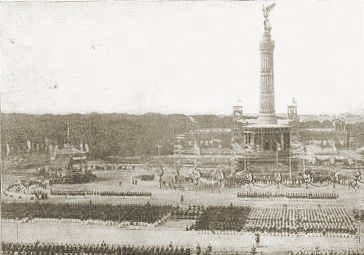Maximilian PLESSNER, Ein
Blick auf die grosten Erfindungen
des zwanzigsten Jahrhunderts.
I. Die
Zukunft des elektrischen Fernsehens.
Ferd. Dämmlers Verlagsbuchhanndlung, Berlin, 1892 [1893].
![]()
The brochure Ein
Blick auf die grossen Erfindungen des zwanzigsten Jahrhunderts:.
I. Die Zukunft des elektrischen Fernsehens,
published in 1893 by Maximilan Plessner, Captain (ret.) in the Royal
Prussian Army,
is one of the most unknown documents of the early history of television.
It has never been quoted in the recent litterature
on this period,
and after two years of research André Lange has identified only one
existing copy in the Österreichische
Zentralbibliothek für Physik (Wien). Only two quotations
of the brochure are known,
and both dated from 1898: in "Jan
Szczepanik und Maximilian Plessner. Der Erfinder des Telektroskops und
sein Vorläufer", Vom Fels zum Meer,
Stuttgart, Mai 1898, pp. 160-165, and in B.
SCHÖFFLER, Die
Phototelegraphie und das elektrische Fernsehen, W. Braumüller, Wien, 1898, p. 27. Although Plessner’s contribution to the history of television can be
considered as minimal, this brochure is of great interest, as demonstrated
by Nils Klevjer Aas' abstract and comments..

Inauguration
of the Siegessäule,
the Column of Victory (Berlin,
1873). Rather than a commemoration column for the celebrating the memory
of the victory of the Prussian Army over France, Maximilian Plessner was
considering the use of the hyaloscope - some kind of VRC - which should
have allowed to show recording of the Great Berlin Parade of 1870 to the
young generations. (Source of the picture : site Deutsches
Kaiserreich)
The originality of this contribution is less on the technical proposal –
Plessner is only one of the many since 1878 proposing an apparatus based
on the selenium properties – than in its insights on the interest for
television and its views on the possible social uses of such a technology.
The hyaloscope suggested by Plessner to record events (such as the
celebration of the victory of the Prussian Army over France) is probably
the first insight of what will be call half a century latter the
videocassette recorder (VCR) or magnetoscope.With his exemple of the
possible recording of the 1870 parade of the victorious Prussian Army,
Plessner also anticipate the propaganda use of film and television. Its
considerations on the probable demographic effects of television were
probably to optimistic but not without interest. And the final addendum by
Plessner about Edison's kinetograph makes this brochure the first text
where the parallel progress of cinema and television are confronted, even
in a very brief manner.
As underlined by Nils Klevjer
Aas’ reading of the brochure, the document is also interresting as a
testimonial of the deluded and frustrated “inventor”, probably
autodidact but convinced of the decisive aspect of its own contribution.
In this sense, the Plessner’s brochure is of the same nature as the one
of his predecessors, Adriano de Paiva’s La
télecopie électrique basée sur l’emploi du sélénium (1880) and Le télectroscope (1881) by Constantin Senlecq and also announce the
Mark Twain article “The Austrian Edison Keeping School Again” (1898)
in defence of the Polish inventor Jan Szczepanik.

The book y R. Ed. Liesegang, published one year
before Plessner own publication, has launched the German word "Fernsehen".
![]()
Translation,
abstracts
and comments by Nils Klevjer AAS
Histoire
de la télévision © A.
Lange
Dernière mise à jour : 23 janvier 2003
![]()



